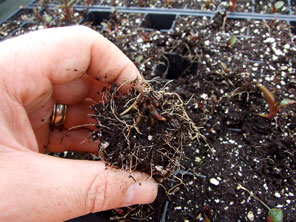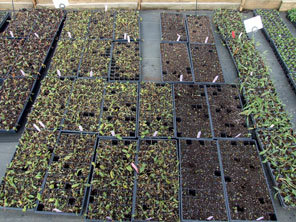3/31/2016
Receiving Starter Plants
Paul Westervelt

Receiving plants is a tedious, but critical, part of the production process. We’ve all experienced “crap in, crap out.” Diligence early can avoid big headaches later.
Our receiving process: Each item has a bed sign that shows the name of the crop, the vendor, the number of flats we’re expecting and liner size. Each bed sign is laid on the floor of the house alphabetically by vendor by program, leaving space for the number of flats so that as we unload, everything is laid out to match the paperwork. This makes check-in much faster. With the plug size and number of flats on the bed sign, it’s easy to do a quick count to be sure there’s not a partial rack still on the truck.
Figure 1. This photo shows a close-up of the issue we face with vernalized echinacea from all vendors.
We then check the tops and roots of every item to make sure it meets our expectations and take photographs of anything troubling. With a camera in almost everyone’s pocket, this is easier than it used to be, but it’s still important to make sure photos show what we want them to. It’s easier to check image clarity while still in the field than to make the trip back to the house to get another image. It’s also important to make sure our picture accurately represents the crop and our concern rather than simply the very worst plug in the flat. All concerns are sent to vendors or brokers with images attached.
While different plants from different vendors have occasional problems, one genera that’s been a consistent problem across genetics and vendors is echinacea—especially vernalized echinacea. I’m under the (possibly mistaken) impression that vernalization isn’t required for echinacea to flower, but results in more blooms, so we source vernalized echinacea whenever possible.
Dried foliage left from last season can quickly be eaten by Botrytis, which follows the dead growth right down to the base and can make short work of the crown. Interestingly, the roots don’t always seem to get the message. I’ve seen hundreds of echinacea plugs with beautiful roots that aren’t connected to anything—they all meet at a hole where the crown was before it rotted. Unfortunately, that plug with the healthy roots and dead crown looks just like its perfectly viable dormant neighbor that’s just planted a little too deep in its cell—unless you carefully explore each plug not showing growth and that’s cost prohibitive.

The first time I questioned this, I got the old “plant them out, they’ll be fine and if they don’t grow we’ll give you credit.” Okay, except I’ll only get credit for the plug—not the pot, soil, fertilizer, tag, labor or time on the ground. The plug cost is a small part of the investment in that package. Our current rule is we have to see some sign of top growth on every echinacea—even if it’s just that little burgundy beak of a dormant bud. Any plant not showing at least that dormant bud goes in the trash.
Figure 2. This was how many plugs in two crops were like the one shown in Figure 1. If we hadn’t removed those plugs, we’d automatically have 7% to 10% shrink!
For a few years, we put questionable plugs on bottom heat for at least two weeks to push them along and planted anything with top growth at the end of that time. Each time, the numbers salvaged were small, and planting those extra few dozen plants per variety in their original house beside those that were planted on time—and were by then well ahead—just led to water issues. Our second rule regarding echinacea plugs is any echinacea that’s blooming in the plug tray gets trashed because I can’t make them stop blooming long enough to size up. Communicating all of this up front has helped us avoid issues.
In case it exists, I’m putting this out there … more than replacements, I want a pre-programmed echinacea. I want it perfectly primed and ready to go—vegetative and actively growing with lots of breaks in each crown. In the last 10 years, we’ve seen annuals that benefit from pre-programming become available across the industry, so why not echinacea?
GT
Paul Westervelt is Annual & Perennial Production Manager for Saunders Brothers, Inc. in Piney River, Virginia.